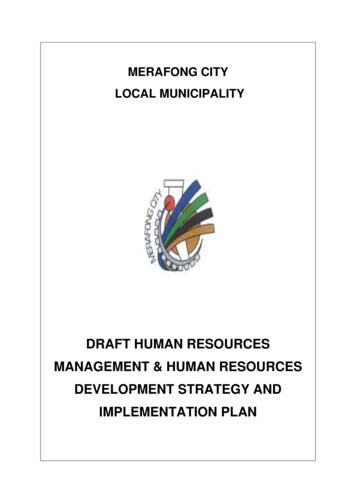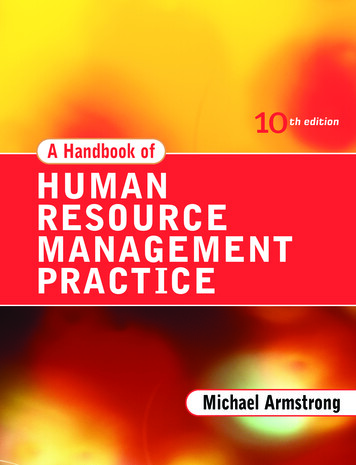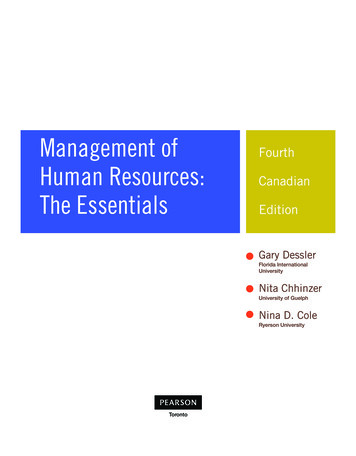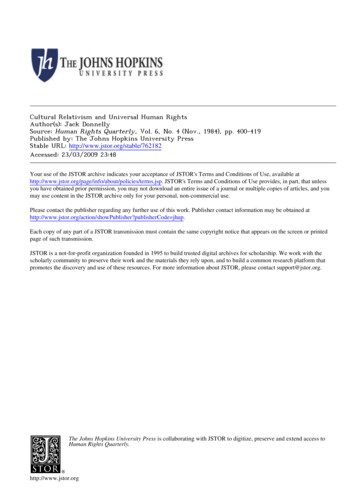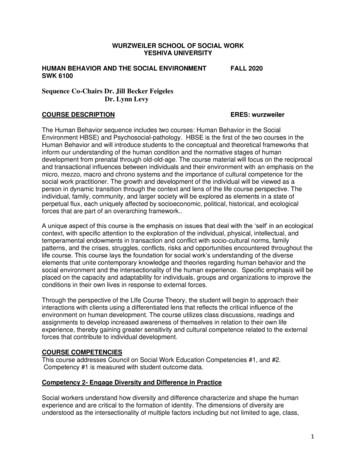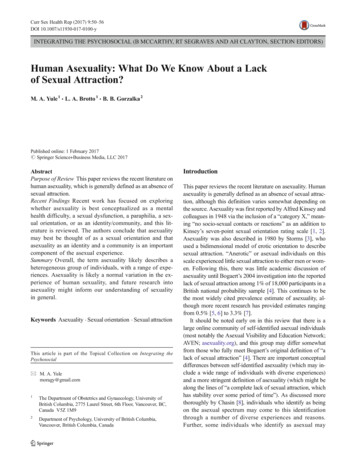
Transcription
Curr Sex Health Rep (2017) 9:50–56DOI 10.1007/s11930-017-0100-yINTEGRATING THE PSYCHOSOCIAL (B MCCARTHY, RT SEGRAVES AND AH CLAYTON, SECTION EDITORS)Human Asexuality: What Do We Know About a Lackof Sexual Attraction?M. A. Yule 1 & L. A. Brotto 1 & B. B. Gorzalka 2Published online: 1 February 2017# Springer Science Business Media, LLC 2017AbstractPurpose of Review This paper reviews the recent literature onhuman asexuality, which is generally defined as an absence ofsexual attraction.Recent Findings Recent work has focused on exploringwhether asexuality is best conceptualized as a mentalhealth difficulty, a sexual dysfunction, a paraphilia, a sexual orientation, or as an identity/community, and this literature is reviewed. The authors conclude that asexualitymay best be thought of as a sexual orientation and thatasexuality as an identity and a community is an importantcomponent of the asexual experience.Summary Overall, the term asexuality likely describes aheterogeneous group of individuals, with a range of experiences. Asexuality is likely a normal variation in the experience of human sexuality, and future research intoasexuality might inform our understanding of sexualityin general.Keywords Asexuality . Sexual orientation . Sexual attractionThis article is part of the Topical Collection on Integrating thePsychosocial* M. A. Yulemoragy@gmail.com1The Department of Obstetrics and Gynaecology, University ofBritish Columbia, 2775 Laurel Street, 6th Floor, Vancouver, BC,Canada V5Z 1M92Department of Psychology, University of British Columbia,Vancouver, British Columbia, CanadaIntroductionThis paper reviews the recent literature on asexuality. Humanasexuality is generally defined as an absence of sexual attraction, although this definition varies somewhat depending onthe source. Asexuality was first reported by Alfred Kinsey andcolleagues in 1948 via the inclusion of a “category X,” meaning “no socio-sexual contacts or reactions” as an addition toKinsey’s seven-point sexual orientation rating scale [1, 2].Asexuality was also described in 1980 by Storms [3], whoused a bidimensional model of erotic orientation to describesexual attraction. “Anerotic” or asexual individuals on thisscale experienced little sexual attraction to either men or women. Following this, there was little academic discussion ofasexuality until Bogaert’s 2004 investigation into the reportedlack of sexual attraction among 1% of 18,000 participants in aBritish national probability sample [4]. This continues to bethe most widely cited prevalence estimate of asexuality, although more recent research has provided estimates rangingfrom 0.5% [5, 6] to 3.3% [7].It should be noted early on in this review that there is alarge online community of self-identified asexual individuals(most notably the Asexual Visibility and Education Network;AVEN; asexuality.org), and this group may differ somewhatfrom those who fully meet Bogaert’s original definition of “alack of sexual attraction” [4]. There are important conceptualdifferences between self-identified asexuality (which may include a wide range of individuals with diverse experiences)and a more stringent definition of asexuality (which might bealong the lines of “a complete lack of sexual attraction, whichhas stability over some period of time”). As discussed morethoroughly by Chasin [8], individuals who identify as beingon the asexual spectrum may come to this identificationthrough a number of diverse experiences and reasons.Further, some individuals who identify as asexual may
Curr Sex Health Rep (2017) 9:50–56experience varying levels of sexual attraction. There havebeen efforts by researchers who are attempting to achieve amore rigorous definition of asexuality to create validated measures of a lack of sexual attraction (e.g., the AsexualityIdentification Scale; AIS; [9]), but efforts to define and studythose who lack sexual attraction entirely is nascent and muchof the research to date is based on samples who self-identify asasexual. Indeed, much of the published literature on asexualityis derived from samples drawn from AVEN, which may represent a very heterogeneous group on the asexual spectrum.As alluded to above asexuality is not currently a welldefined construct, at least not from a standpoint of scientificrigor, and definitions vary. Bogaert [4, 10] defined asexuality asa lack of sexual attraction, and this definition is routinely usedin research. More specifically, asexuality has been defined as alack of sexual attraction to anyone [4], as well as a lack ofsexual attraction entirely (i.e., to anyone or anything) [11].Overall, the lack of sexual attraction is thought to be persistentthroughout an asexual individual’s adult life, although this isnot a requirement for self-identification as asexual within theasexual community [11].In terms of sexual attraction, romantic attraction, and sexual behavior, there is a range of experiences that might transpire within individuals on the asexual spectrum. Among theasexual community, there is recognition that some asexualindividuals do experience sexual attraction in some circumstances, or with particular individuals, and these individualsmight identify as “gray asexual” (or “gray-A”: a person whomay only rarely experience sexual attraction) or demi-sexual(a person who experiences sexual attraction only when theyform a strong emotional connection with someone) [12].Other terms that might be used within the asexual communityto classify a person who experiences very little sexual attraction include semi-sexual, asexual-ish, and hyposexual.Orthogonal to their sexual attraction is an individual’s inclination for romantic attraction, defined as a desire for a romanticrelationship, perhaps with a particular person. It is well knownthat asexual individuals vary widely in this propensity forromantic affiliation, ranging from aromantic (a person whoexperiences little to no romantic attraction) to panromantic(romantically attracted to others, and this attraction is not limited by sex or gender) to heteroromantic or homoromantic.It is important to emphasize that the lack of sexual attraction that seems to be fundamental to asexuality does not necessarily equate to a lack of sexual behavior, and there is evidence that asexual individuals engage in both partnered andsolitary sexual activity [13, 14] for a variety of reasons unrelated to sexual attraction, that might include involvement in aromantic relationship. In addition to challenging the assumption that asexuality implies an outright absence of all sexualactivity, there are a number of other pervasive stereotypesapplied to those identifying as asexual. For example, someassume all asexual individuals are aromantic, female, afraid51of sex, highly religious, have experienced traumatic relationships or sexual experiences, have low testosterone levels orsome other physical problem, or are making a consciouschoice to be asexual (e.g., celibacy; [15–17]), and these opinions have also been expressed by clinicians and academics[17]. Empirical research, however, has provided evidence thatthese claims are largely false [10, 18 , 19 ].The emergence of the asexual community, combined with alack of empirical data on asexuality, has led to much discussion and speculation, both within academic and non-academiccommunities, on how asexuality should be conceptualized.Asexuality has been described as a sexual orientation by anumber of sources [3, 4, 13, 18 , 20, 21, 22 ], and heterosexual and non-heterosexual sexual orientation groups have beenused as a comparison to asexual groups in a number of studies(e.g., [23, 24]). Although the writers acknowledge alternatedefinitions of “sexual orientation” (i.e., as a sociopolitical category; see [8]), we define it here as an internal mechanism thatdirects a person’s sexual interest toward men, women, or both(or potentially toward individuals who do not identify as maleor female). In contrast to understanding asexuality as a sexualorientation, there has also been speculation [19 ] that asexuality could arise from, or be part of, a mental health difficulty,a sexual dysfunction (defined in the Diagnostic and StatisticalManual of Mental Disorders as “a clinically significant disturbance in a person’s ability to respond sexually or to experiencesexual pleasure”; DSM-5, [25]), or possibly even a paraphilia.Much of the current empirical research focuses on these questions, and this literature will be reviewed here. Recent writingson asexuality have also explored the social context of asexuality, and we also include a brief discussion of asexual identities and communities.Asexuality as a Mental Health DifficultyThere is some evidence for a relationship between autismspectrum disorders (ASD) and asexuality. In response to indepth semi-structured interviews with a sample of asexualindividuals drawn from AVEN, Brotto and colleagues [13]noted that a number of their participants discussed the potential link between the Asperger syndrome and asexuality, andIngudomnukul and colleagues [26] found that 17% of womenwith ASD stated that they were asexual or had a preference forneither sex, compared to none of the women in their controlgroup. Gilmour, Schalomon, and Smith [27] also found higherrates of asexuality among autistic participants. Further, datapresented by Chasin [8] indicates that approximately 6% ofautistic men and women reported having no sexual interest foranyone as well as not identifying with any sexual orientation.As Pecora et al. [28] points out, there is evidence that individuals on the autism spectrum may demonstrate a more diverserange of sexual interests (homosexual, bisexual, and asexual)
52as well as having a higher representation of gender dysphoriathan in the general population.Yule, Brotto, and Gorzalka [29 ] found asexuality to beassociated with a higher prevalence of mental health and interpersonal problems. Specifically, asexual individuals weremore likely to endorse symptoms of social withdrawal on aself-report screener for personality symptoms and to reportmore interpersonal difficulties in general. Asexual individualswere also more likely to report symptoms of anxiety and toendorse more symptoms of suicidality compared to nonasexual participants. Despite these symptoms, it is reasonableto conclude that asexuality should not be classified as either amental illness, nor be conceptualized as a symptom of a psychiatric condition. Based on the findings of MacInnis andHodson [24], which suggested that college students evaluatedasexual individuals most negatively compared to other sexualorientation groups and asexual individuals were seen to be theleast likely to possess “human nature traits,” it is likely that theelevated rates of mental health symptoms observed in somestudies of asexual individuals can be explained by their experience of stigmatization and dehumanization.Overall, these findings strongly suggest that increased experience of distress and associated mental health difficultiesshould not be used to pathologize asexual individuals [10] andthat asexuality should not be classified as a psychiatric diagnosis, nor be seen as a symptom of one. It remains a possibilitythat, for those asexual individuals who do have symptoms ofautism spectrum disorder, distress arises from these mentalhealth conditions, rather than from the asexuality itself. Thisgroup is understudied, and much more research needs to bedone to understand this further.Asexuality as a Sexual DysfunctionGiven that lack of interest in sex is a hallmark feature ofasexuality, it is understandable that speculation has arisenabout whether asexuality is not simply an extreme case oflow sexual desire. In order to evaluate whether asexual individuals may experience impairments to their physical sexualresponse, one study compared genital sexual arousal betweenasexual, bisexual, heterosexual, and lesbian women in response to erotic films [21]. There was no significant differencein genital sexual arousal, as measured by vaginalphotoplethysmography, between groups. However, the asexual women differed from the sexual women in that they reported no increase in desire for sex after viewing the eroticfilms [21]. Thus, it does not seem that a lack of sexual arousalin response to sexual triggers underlies asexual individuals’lack of sexual attraction. Whether genital arousal patterns ofasexual men differ from other sexual orientation groups is todate unknown and is currently the subject of at least two studies at the University of British Columbia, Brock University,and Northwestern University.Curr Sex Health Rep (2017) 9:50–56It has also been speculated that asexuality may be understood under the umbrella of a dysfunction of sexual desire, suchas hypoactive sexual desire disorder (HSDD) or female sexualinterest/arousal disorder (FSIAD). As discussed by Hinderliter[30], the conflation between sexual desire disorders and asexuality is problematic for the asexual community, whose goal, inpart, is for asexuality to be seen as a “normal variation” on thespectrum of human sexuality. That asexuality and sexual desiredisorders are different has some empirical backing. One recentstudy found significant differences between participants whomet diagnostic criteria for a desire disorder and self-identifiedasexual individuals. Specifically, Brotto, Yule, and Gorzalka[31 ] found that participants who met criteria for a desire disorder endorsed higher sex-related distress, had higher levels ofsexual desire, were more likely to be in a relationship, and hadlower alexithymia scores (i.e., inability to identify and expressemotions) than did asexual participants. Moreover, studies havefind their lack of sexual desire to be problematic, and, if giventhe choice, they did not wish to speak with a health care provider about it [32, 33]. Kristina Gupta [34 ] conducted an indepth qualitative study of 30 asexual individuals and concludedthat the distinction between a disorder of sexual desire andasexuality is not clear-cut, and that, because it might arise inresponse to stigma or relationship difficulties, distress alonemay not separate asexual individuals from those with a sexualdysfunction.From these studies, we suggest that asexuality does notappear to be a disorder of sexual arousal, nor of sexual desire.However, as discussed by Brotto and Yule [18 ], there remains a possibility that at least some individuals diagnosedwith a lifelong sexual desire disorder might be better classifiedas asexual. Brotto, Yule, and Gorzalka [31 ]compared individuals who met diagnostic criteria for lifelong HSDD with asexual individuals. Those with lifelong HSDD scored lower on ameasure of asexuality (the AIS [9], described above), andreported greater sexual-related distress than did asexual participants. The two groups did not differ on total sexual behaviorsor on level of sexual desire. Overall, this suggests that there ispotentially a large amount of overlap between the two groups.It may be that some individuals who meet diagnostic criteriafor lifelong HSDD might self-identify as asexual if they wereaware of the term. It may be that the clinically significantdistress required to make a diagnosis of lifelong sexual desiredisorder could arise in response to attempting to navigate arelationship with a (sexual) partner, despite a person remaining disinterested in engaging in sexual activity otherwise[18 ], or from the experience of stigma [33, 34 ]. Further,the previously discussed discrimination that asexual individuals experience [24] may also result in distress that could beclinically significant. More research is required to determinethe extent of overlap between these groups.There are important clinical implications of the finding thatasexuality is not likely to be a sexual dysfunction. The goal in
Curr Sex Health Rep (2017) 9:50–56treatment for the person with a sexual desire or arousal disorder is to increase their interest in sex, whereas, based on thecurrent evidence, an asexual person in therapy would be morelikely to benefit from a focus on self-acceptance [30], or ondeveloping skills around navigating relationships, especiallyif their partner was sexual and motivated to have sex. Guptarecommended that clinicians who work with individuals whoexperience low levels of sexual interest should encourage exploration of which label (“HSDD” vs. “asexual”) fits best forthe client and would allow them to lead a fulfilling life [34 ].In the DSM-5, the accompanying text for the sexual desiredisorders (both FSIAD in women and HSDD in men) explicitly mentions asexuality as an exclusion criterion [25].Asexuality as a ParaphiliaParaphilias are defined as non-normative or atypical sexualinterests. A paraphilia itself is not necessarily considered adisorder. To meet diagnostic criteria for a paraphilic disorder,an individual’s atypical sexual interest must cause clinicallysignificant distress in themselves or another person (i.e., if thetarget of the sexual interest is an unwilling partner or child;[25]). Evidence that asexual individuals engage in masturbation [13, 14, 35 ] has led to speculation [36 ] that asexualindividuals might have some sexual interest that is not directed toward a partner, and that this may be understood to be aparaphilic sexual interest. Bogaert, in his 2006 [10] discussionof asexuality and paraphilias noted that the likelihood of allasexual individuals being paraphilic was low. Paraphilia without any human interest is rare, and more frequently occurs inmen [4, 6], while asexual individuals are more frequentlywomen [4, 13]. However, Bogaert [37] also questionedwhether some asexual individuals might have a particular typeof paraphilia, namely autochorissexuality, which he defined as“identity-less sexuality.” Individuals who experienceautochorissexuality see their identity as being separate fromsexual acts that they might be engaging in or fantasizingabout. For example, Yule, Brotto, and Gorzalka [35 ] askedasexual (and sexual) individuals who engage in sexual fantasywhat they fantasize about. Thirty-three percent of asexualwomen (compared to 8% of sexual women) and 19% of asexual men (compared to none of the sexual men) reported thattheir sexual fantasies did not involve them. For example, oneparticipant stated: “I don’t put myself into my fantasies. Thatis thoroughly unappealing to me. Instead, I imagine otherpeople in sexual situations, and focus on their thoughts andfeelings for a sort of vicarious arousal.” ([35 ] pg. 6).The study by Yule et al. [35 ] also found that asexual individuals fantasize about a number of topics, including some thathave traditionally been thought of as non-normative, such asBDSM (bondage-discipline-sadism-masochism). We suggest,however, that rather than understanding that asexual individuals have paraphilic sexual interests, it may be that these53interests, which have been traditionally seen to be “non-normative” are much more frequently experienced than was oncethought [38, 39]. Thus, it may be that asexual individuals doexperience sexual interest, but that they are not motivated todirect this interest toward anyone or anything, aside from, perhaps, themselves while engaging in masturbation. More research needs to be done in this area.Asexuality as a Sexual OrientationSexual orientation is thought to be a largely undefined internalmechanism that directs a person’s sexual interest, with varyingdegrees, toward men, women, or both [40], and asexual advocates maintain that asexuality is a unique sexual orientation,alongside heterosexuality, homosexuality, and bisexuality. Ithas been suggested that it may be more accurate to conceptualize asexuality as a lack of sexual orientation, in that thisinternal mechanism is not directed toward anyone or anything,or might not exist at all. It may also be that the same processesthat guide the direction of sexual attraction to men, women, orboth, might be involved in the development of a lack of sexualattraction. By investigating markers previously associatedwith sexual orientation development, such as age of menstruation, shorter stature, and increased number of health problems [4, 6], and potential biological markers of prenatal environment such as handedness and number of older siblings[22 ], researchers have provided evidence that the same processes that influence these markers of sexual orientation maybe associated with the development of the lack of sexual [10,13, 21, 22 ]. Because of this, Brotto and Yule [18 ] argue thatasexuality be conceptualized as a unique sexual orientationrather than the absence of one.It is important to note that temporal stability over time isone criterion for categorizing something as a sexual orientation [41, 42]. Cranney [43] found relatively low stability overtime when investigating two separate waves of data queryinglack of sexual attraction in the Add Health survey. He hassuggested, however, that this may not be evidence againstasexuality as a sexual orientation. This is in part because itwas generally concluded that homosexuality was an intrinsic,lifelong state before there was any formal longitudinal evidence of it being long lasting. Cranney argues that asexualindividuals should be provided the same good faith as werelesbians and gay men when describing their lack of sexualattraction as being non-problematic and a long-lasting partof their experience [44]. He also noted that our current measurement of asexuality most frequently involves a single queryabout whether a participant lacks sexual attraction. It may wellbe that sexual attraction and romantic attraction are conflatedby individuals who are not familiar with the terms used byresearchers. See [9] for a more in-depth discussion of themeasurement of asexuality for research purposes.
54Curr Sex Health Rep (2017) 9:50–56Evidence of fluidity of sexual attraction among othergroups, particularly among women [45]. The existence ofdemi-sexual individuals, who become attracted to someoneonly after an emotional bond has been formed, suggests thatthere is some fluidity in at least some people who identify aswithin the asexual spectrum.suggests very practical outcomes for practitioners and researchers to explore the quality of relationships, includingbut not limited to asexuality, in more detail.Asexuality as an Identity and CommunityAsexuality challenges the ubiquitous notion that sexuality is auniversal human experience. Overall, there is convincing evidence that a lack of sexual attraction is not the result of amental health disturbance, a sexual dysfunction, or necessarilya paraphilia, and that asexuality is best thought of as a sexualorientation. While we strongly feel that asexuality is a validpresentation and should not be seen as a pathology, we alsosuggest that individuals presenting to a clinician’s office expressing low sexual attraction do deserve a comprehensivemental health assessment to recognize and deal with potentialpsychological and relational difficulties that might arise as aresult of this. Asexuality, as has been suggested by previouswriters (e.g., [24, 29 ]), may be associated with discriminationand difficulty navigating relationships, which may come withits own set of problems.Recognizing asexuality as an identity and as a communityis an important component of the asexual experience that academics should incorporate into their research. Of course, it islikely that the term asexuality is used to describe a heterogeneous group, with a wide range of sexual attractions and sexual behaviors (or lack thereof). Overall, asexuality is likely anormal variation in the experience of human sexuality, andfuture research into asexuality might inform our understanding of sexuality in general.Scherrer [46 ] pointed out that social scientists understandsexuality in three ways: behavior, desire, and identity[47]. As discussed, asexuality research has generally focused on lack of sexual behavior and lack of sexual desire. Scherrer argues that a focus on asexual identity isessential to understanding asexuality fully. An exampleof its importance was underscored by Gressgard [48],who suggested that the subjective identity dimension ofsexual orientation allows asexual individuals to exerciseself-determination based on what they perceive to be thereality of their own sexuality. Scherrer provides an interesting discussion on how asexual individuals come to anasexual identity and concluded that understanding asexualidentities provides alternative ways of understanding sexual identities in general [46 ].More recently, Scherrer and Pfeffer [49] argued thatasexuality is, in fact, best understood as an identity and acommunity, rather than as a sexual orientation or any othercategory discussed above. Identity, defined as “the waythat people understand themselves and the language theyuse to explain themselves to others” [49], pg. 3, providespeople with both a social and internal place from which tounderstand themselves. Community allows the broaderunderstanding of this identity in the context of relationships and social interactions. Scherrer and Pfeffer [49]suggested that conceptualizing asexuality as an identityand a community will allow us to avoid pathologizing alack of sexual attraction and will rather allow us to extendand explore further our understanding of sexuality andgender on a wider scale. For example, Scherrer [50]discussed how asexuality challenges and extends our understanding of sexual people’s relationships. In examiningqualitative data from 102 self-identified asexual individuals, Scherrer [50] challenged problematic assumptionsabout sex and sexuality in relationships among sexual minorities. Her analysis revealed a wide range of definitionsof “relationship” and underscored the conflation of andintimacy among the study’s participants. Traditionally,sex is used to delineate romantic relationships from friendships, and asexuality blurs this boundary. When understanding asexuality as an identity that is used to navigaterelationships, we understand that there are a wide range ofpossible relationships, aside from the traditional dichotomy of “in a relationship” or “single.” Scherrer’s workConclusionCompliance with Ethical StandardsConflict of Interest M. A. Yule, L.A. Brotto, and B. B. Gorzalka eachdeclare no potential conflicts of interest.Human and Animal Rights and Informed Consent This article doesnot contain any studies with human or animal subjects performed by anyof the authors.ReferencesPapers of particular importance, published recently, have beenhighlighted as: Of importance Of major importance1.2.3.Kinsey AC, Pomeroy WB, Martin CE. Sexual behavior in the human male. Philadelphia: WB Saunders Co; 1948.Kinsey AC. Sexual behavior in the human female. Philadelphia:WB Saunders Co; 1953.Storms MD. Theories of sexual orientation. J Pers Soc Psychol.1980;38(5):783–92.
Curr Sex Health Rep (2017) 9:50–564.5.6.7.8.9.10.11.12.13.14.15.16.17.18. 19. 20.21.22. 23.24.25.Bogaert AF. Asexuality: prevalence and associated factors in a national probability sample. J Sex Res. 2004;41(3):279–87.Aicken CRH, Mercer CH, Cassell JA. Who reports absence ofsexual attraction in Britain? Evidence from national probabilitysurveys. Psychol Sex. 2013;4(2):121–35.Bogaert AF. The demography of asexuality. In: International handbook on the demography of sexuality. Netherlands: Springer; 2013.p. 275–88.Höglund J, Höglund J, Jern P, Jern P, Sandnabba NK, SandnabbaNK, et al. Finnish women and men who self-report no sexual attraction in the past 12 months: prevalence, relationship status, andsexual behavior history. Arch Sex Behav. 2014;43(5):879–89.Chasin C. Considering asexuality as a sexual orientation and implications for acquired female sexual arousal/interest disorder. ArchSex Behav. 2016. Online First. doi:10.1007/s10508-016-0893-1.Yule MA, Brotto LA, Gorzalka BB. A validated measure of nosexual attraction: the Asexuality Identification Scale. PsycholAssess. 2015;27(1):148–60.Bogaert AF. Toward a conceptual understanding of asexuality. RevGen Psychol. 2006;10(3):241–50.Asexual Visibility and Education Network (AVEN) [Internet]. 2011[cited 2017 Jan 11]. Available from: asexuality.org.Mosbergen D. The asexual spectrum: identities in the ace community. 2016. Retrieved from pectrum n 3428710.html.Brotto LA, Knudson G, Inskip J, Rhodes K. Asexuality: a mixedmethods approach. Arch Sex Behav. 2010;39(3):599–618.Yule MA, Brotto LA, Gorzalka BB. Sexual fantasy and masturbationamong asexual individuals. Can J Hum Sex. 2014;23(2):89–95.NextStepCake. I’m an aromantic asexual. [Blog]. Retrieved /southpawscopicbuildmeatower-the-whole-thing. 13 May 2011.The View. Secrets of asexuals [video clip]. Available fromhttp://www.youtube.com/watch?v 6kPfLYuQlL8 2006.Sloan D (Director). 20/20, March 24. [Television series episode].In: Sloan D (Executive Producer), Cincinnati, OH: ABC NewsProductions; 2006.Brotto LA, Yule M. Asexuality: sexual orientation, paraphilia, sexual dysfunction, or none of the above? Arch Sex Behav. 2016.Online First. doi:10.1007/s10508-016-0802-7. This review paperprovides a discussion of how asexuality might best beconceptualized.Bogaert AF. Asexuality: what it is and why it matters. J Sex Res.2015;52(4):362–79. This paper provides a discussion of whatasexuality studies can reveal about sexuality in general.Berkey BR, Perelman-Hall T, Kurdek LA. The multidimensionalscale of sexuality. J Homosex. 1990;19(4):67–88.Brotto LA, Yule MA. Physiological and subjective sexual arousal inself-identified asexual women. Arch Sex Behav. 2011;40(4):699–712.Yule MA, Brotto LA, Gorzalka BB. Biological markers of asexuality: handedness, birth order, and finger length ratios in selfidentified asexual men and women. Arch Sex Behav. 2014;43(2):299–310. This study demonstrates that biological markers, suchas handedness an
whether asexuality is best conceptualized as a mental health difficulty, a sexual dysfunction, a paraphilia, a sex- ual orientation, or as an identity/community, and this lit-erature is reviewed. The authors conclude that asexuality may best be thought of as a sexual orientation and that asexuality as an identity and a community is an important component of the asexual experience. Summary .



